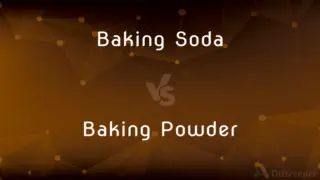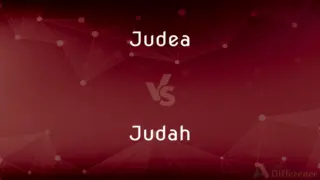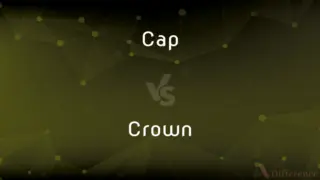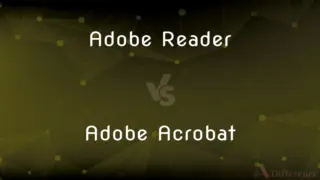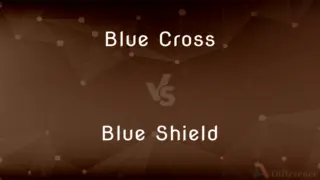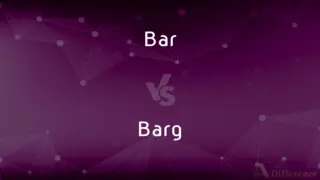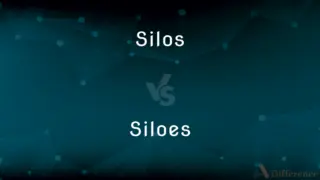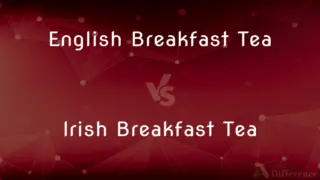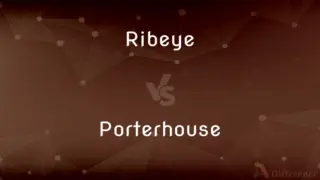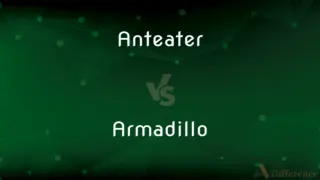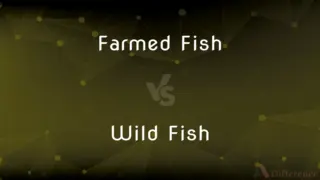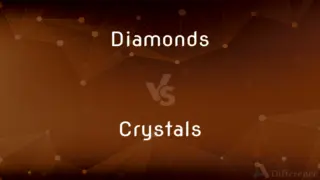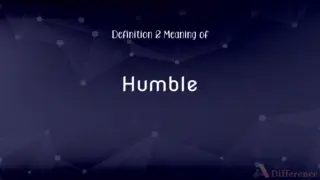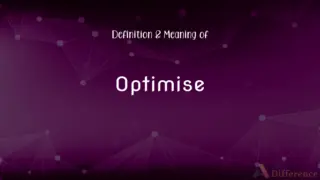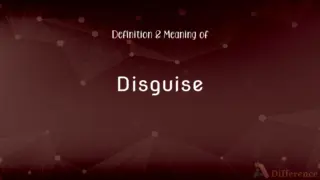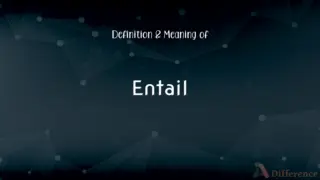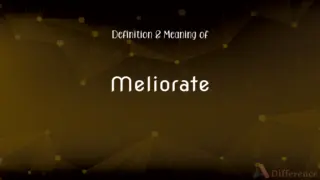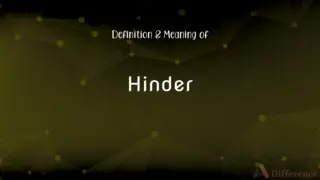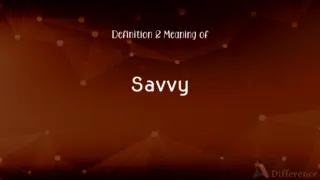Tile vs. Brick — What's the Difference?
By Urooj Arif & Maham Liaqat — Updated on March 10, 2024
Tile is primarily used for flooring and wall coverings, known for its smooth surface and decorative appeal, whereas brick is a sturdy building material used for construction and paving, valued for its durability and structural support.

Difference Between Tile and Brick
Table of Contents
ADVERTISEMENT
Key Differences
Tiles are manufactured pieces of hard-wearing material such as ceramic, stone, metal, or even glass. They are generally used for covering roofs, floors, walls, or other objects such as tabletops. Tiles are chosen for their ability to resist wear and moisture, making them ideal for bathrooms, kitchens, and other areas prone to wet conditions. On the other hand, bricks are a type of block made from clay that has been molded and then hardened by firing in a kiln. Bricks are primarily used for building walls, pavements, and other elements in masonry construction. They are prized for their strength, durability, and ability to provide significant structural support.
The production process for tiles can vary widely, depending on the type of tile being made. For example, ceramic tiles are made from clay and other inorganic materials that are shaped and then fired at high temperatures. Whereas bricks are made from a clay or shale mixture that is shaped into blocks before being fired in a kiln to achieve their final hardness. This fundamental difference in production reflects the distinct uses and properties of each material.
Tiles offer a wide range of colors, patterns, and sizes, making them a popular choice for decorative finishes within homes and buildings. They can mimic various textures, including wood and stone, providing versatility in design. Bricks, while less varied in color and pattern, impart a traditional and warm aesthetic to buildings. The natural variation in clay colors can range from light creams to deep reds, offering some customization in appearance.
In terms of installation, tiling is a precise process that often requires the application of a mortar or adhesive to secure the tiles to surfaces, followed by grouting between tiles to prevent moisture penetration and create a finished look. Bricklaying, however, involves the strategic stacking of bricks with mortar to bind them together, forming a sturdy structure. This process requires a different set of skills and tools compared to tiling.
Durability and maintenance of tiles and bricks also differ. Tiles, especially ceramic and porcelain, are resistant to stains, water, and wear, making them easy to maintain with regular cleaning. However, they can crack or chip upon impact. Bricks are extremely durable and can last for centuries with minimal maintenance, but they can be susceptible to moisture absorption and might require sealing in certain environments.
ADVERTISEMENT
Comparison Chart
Primary Use
Flooring, wall coverings
Construction, paving
Material
Ceramic, stone, metal, glass
Clay, shale
Production Process
Shaped and fired at high temperatures
Molded and kiln-fired
Aesthetic Variety
High (colors, patterns, sizes)
Lower (natural clay colors)
Installation
Mortar/adhesive and grouting
Mortar and strategic stacking
Durability
High (with potential for cracking/chipping)
Very high (with minimal maintenance)
Moisture Resistance
High
Moderate (may require sealing)
Compare with Definitions
Tile
Resistant to stains and water when properly sealed.
The porcelain tiles in the shower area are designed to resist mold and mildew.
Brick
Known for its durability and strength.
The brick walls of the old fortress have withstood centuries of weather.
Tile
Known for its smooth surface and decorative qualities.
The kitchen backsplash featured hand-painted tiles.
Brick
A building material made from clay that's been molded and baked.
The new library was constructed with red bricks for a classic look.
Tile
Offers versatility in design and application.
Glass tiles were used to create a feature wall in the lobby.
Brick
Used for structural support and paving.
They chose interlocking bricks for the driveway to enhance curb appeal.
Tile
A thin slab of fired clay, metal, or other material used for covering floors or walls.
They installed blue ceramic tiles in the bathroom.
Brick
Offers a traditional aesthetic with natural color variations.
The sunroom's exposed brick added warmth and character to the space.
Tile
Easy to maintain and clean, ideal for wet areas.
The tile flooring made cleaning up spills in the dining room a breeze.
Brick
Requires minimal maintenance, though may need sealing.
Sealing the bricks on the patio helped to prevent water damage and moss growth.
Tile
Tiles are thin objects, usually square or rectangular in shape. A tile is a manufactured piece of hard-wearing material such as ceramic, stone, metal, baked clay, or even glass, generally used for covering roofs, floors, walls, or other objects such as tabletops.
Brick
A brick is a type of block used to build walls, pavements and other elements in masonry construction. Properly, the term brick denotes a block composed of dried clay, but is now also used informally to denote other chemically cured construction blocks.
Tile
A thin, flat or convex slab of hard material such as baked clay or plastic, laid in rows to cover walls, floors, and roofs.
Brick
A small rectangular block typically made of fired or sun-dried clay, used in building.
Tile
A short length of pipe made of clay or concrete, used in sewers and drains.
Brick
A large and relatively heavy mobile phone, typically an early model with limited functionality
I had one of those Motorola bricks as my first cell phone
Tile
A hollow fired clay or concrete block used for building walls.
Brick
A generous, helpful, and reliable person
‘You are really a brick, Vi,’ Gloria said
Tile
Tiles considered as a group
Bought tile for the kitchen.
Brick
Block or enclose with a wall of bricks
The doors have been bricked up
Tile
(Games) A marked playing piece, as in mahjong.
Brick
Throw bricks at
The pub was attacked and windows in the area were bricked
Tile
To cover or provide with tiles.
Brick
Cause (a smartphone or other electronic device) to become completely unable to function, typically on a permanent basis
Installing an unofficial OS voids the warranty and may brick the phone
Tile
A regularly-shaped slab of clay or other material, affixed to cover or decorate a surface, as in a roof-tile, glazed tile, stove tile, carpet tile, etc.
Brick
Be extremely worried or nervous.
Tile
(computing) A rectangular graphic.
Each tile within the map consists of 256 × 256 pixels.
Sprites and tiles that are hidden in the prototype ROM file can be recovered.
Brick
A molded rectangular block of clay baked by the sun or in a kiln until hard and used as a building and paving material.
Tile
Any of various flat cuboid playing pieces used in certain games, such as dominoes, Scrabble, or mahjong.
Brick
Such blocks of clay used as a building material
A house made of brick.
Tile
A stiff hat.
Brick
An object shaped like such a block
A brick of cheese.
Tile
(transitive) To cover with tiles.
The handyman tiled the kitchen.
White marble tiled the bathroom.
Brick
(Informal) A smartphone, tablet, or similar electronic device that connects to the internet that has become inoperable.
Tile
(GUI) To arrange in a regular pattern, with adjoining edges (applied to tile-like objects, graphics, windows in a computer interface).
Brick
A dark brownish red.
Tile
(comptheory) To optimize (a loop in program code) by means of the tiling technique.
Brick
(Informal) A helpful, reliable person.
Tile
(freemasonry) To seal a lodge against intrusions from unauthorised people.
Brick
(Basketball) A shot that falls short of the basket.
Tile
To protect from the intrusion of the uninitiated.
To tile a Masonic lodge
Tile the door
Brick
To construct, line, or pave with bricks.
Tile
To protect from the intrusion of the uninitiated; as, to tile a Masonic lodge.
Brick
To close or wall with brick
Bricked up the windows of the old house.
Tile
To cover with tiles; as, to tile a house.
Brick
(Informal) To cause to become inoperable. Used especially of electronic devices, such as smartphones and tablets, that connect to the internet. I bricked my smartphone when I tried to untether it.
Tile
Fig.: To cover, as if with tiles.
The muscle, sinew, and vein,Which tile this house, will come again.
Brick
(Informal) To become inoperable. Used especially of electronic devices, such as smartphones and tablets, that connect to the internet.
Tile
A plate, or thin piece, of baked clay, used for covering the roofs of buildings, for floors, for drains, and often for ornamental mantel works.
Brick
(countable) A hardened rectangular block of mud, clay etc., used for building.
This wall is made of bricks.
Tile
A small slab of marble or other material used for flooring.
Brick
(uncountable) Such hardened mud, clay, etc. considered collectively, as a building material.
This house is made of brick.
Tile
A small, flat piece of dried earth or earthenware, used to cover vessels in which metals are fused.
Brick
(countable) Something shaped like a brick.
A plastic explosive brick
Tile
A draintile.
Brick
A helpful and reliable person.
Thanks for helping me wash the car. You're a brick.
Tile
A stiff hat.
Brick
A shot which misses, particularly one which bounces directly out of the basket because of a too-flat trajectory, as if the ball were a heavier object.
We can't win if we keep throwing up bricks from three-point land.
Tile
A flat thin rectangular slab (as of fired clay or rubber or linoleum) used to cover surfaces
Brick
(informal) A power brick; an external power supply consisting of a small box with an integral male power plug and an attached electric cord terminating in another power plug.
Tile
A thin flat slab of fired clay used for roofing
Brick
An electronic device, especially a heavy box-shaped one, that has become non-functional or obsolete.
Tile
Cover with tiles;
Tile the wall and the floor of the bathroom
Brick
A projectile.
Brick
(firearms) A carton of 500 rimfire cartridges, which forms the approximate size and shape of a brick.
Brick
(poker slang) A community card (usually the turn or the river) which does not improve a player's hand.
The two of clubs was a complete brick on the river.
Brick
The colour brick red.
Brick
(slang) A kilogram of cocaine.
Brick
Extremely cold.
Brick
(transitive) To build, line, or form with bricks.
Brick
(transitive) To make into bricks.
Brick
To hit someone or something with a brick.
Brick
To make an electronic device nonfunctional and usually beyond repair, essentially making it no more useful than a brick.
My VCR was bricked during the lightning storm.
Brick
To blunder; to screw up.
Brick
A block or clay tempered with water, sand, etc., molded into a regular form, usually rectangular, and sun-dried, or burnt in a kiln, or in a heap or stack called a clamp.
The Assyrians appear to have made much less use of bricks baked in the furnace than the Babylonians.
Brick
Bricks, collectively, as designating that kind of material; as, a load of brick; a thousand of brick.
Some of Palladio's finest examples are of brick.
Brick
Any oblong rectangular mass; as, a brick of maple sugar; a penny brick (of bread).
Brick
A good fellow; a merry person; as, you 're a brick.
Brick
To lay or pave with bricks; to surround, line, or construct with bricks.
Brick
To imitate or counterfeit a brick wall on, as by smearing plaster with red ocher, making the joints with an edge tool, and pointing them.
Brick
Rectangular block of clay baked by the sun or in a kiln; used as a building or paving material
Brick
A good fellow; helpful and trustworthy
Common Curiosities
Can bricks be used for flooring?
Yes, bricks can be used for flooring, especially in outdoor spaces or for creating a rustic look indoors, but they require sealing for moisture protection.
How long do tile floors last?
Tile floors, particularly those made of porcelain or ceramic, can last for decades if properly installed and maintained.
Can tiles be used outdoors?
Yes, tiles designed for outdoor use, such as porcelain, are durable and weather-resistant, making them suitable for patios and exterior walls.
Are bricks environmentally friendly?
Bricks are considered a sustainable building material due to their durability, natural composition, and energy efficiency in buildings.
Do bricks need to be sealed?
While bricks are inherently durable, sealing them can enhance moisture resistance and prevent staining, especially in climates with freeze-thaw cycles.
What's the difference between porcelain and ceramic tiles?
Porcelain tiles are made from denser clay and fired at higher temperatures, making them more durable and less porous than ceramic tiles.
How are bricks made?
Bricks are made by shaping clay or shale into blocks, drying them, and then firing them in a kiln at high temperatures to harden.
What are the advantages of brick construction?
Brick construction offers advantages such as thermal mass, durability, low maintenance, and aesthetic appeal.
Are there eco-friendly bricks?
Yes, bricks made from recycled materials or produced with energy-efficient methods are considered more eco-friendly.
Can tile be recycled?
Yes, certain types of tile can be recycled, though the process and feasibility depend on the material composition of the tile.
What maintenance do tiles require?
Tiles require regular cleaning and sealing (for certain types) to maintain their appearance and moisture resistance.
Can bricks be painted?
Yes, bricks can be painted, but they require special preparation and paint to ensure adhesion and durability.
Is tile flooring slippery?
Some tiles, especially when wet, can be slippery, but textured or anti-slip tiles are available for areas prone to moisture.
How do weather conditions affect bricks?
Extreme weather conditions can cause bricks to expand or contract, leading to potential cracking or spalling, which is why proper installation and maintenance are crucial.
What is a glazed tile?
A glazed tile has a glass-like coating applied before firing, making it impervious to water and stains, and available in various colors and designs.
Share Your Discovery

Previous Comparison
Nerd vs. Anorak
Next Comparison
Bitter vs. SharpAuthor Spotlight
Written by
Urooj ArifUrooj is a skilled content writer at Ask Difference, known for her exceptional ability to simplify complex topics into engaging and informative content. With a passion for research and a flair for clear, concise writing, she consistently delivers articles that resonate with our diverse audience.
Co-written by
Maham Liaqat



